Toshiba Satellite L645D: Mobile AMD at 3GHz
by Dustin Sklavos on March 9, 2011 3:20 AM ESTMostly Portable
A point where AMD-based notebooks have traditionally suffered (with the notable exceptions of both Sony's EE34 and pretty much anything Fusion-based) is battery running time. Toshiba equips the L645D with a mediocre six-cell, 48Wh battery that may somewhat dampen the mobility of a notebook that's otherwise fairly portable.
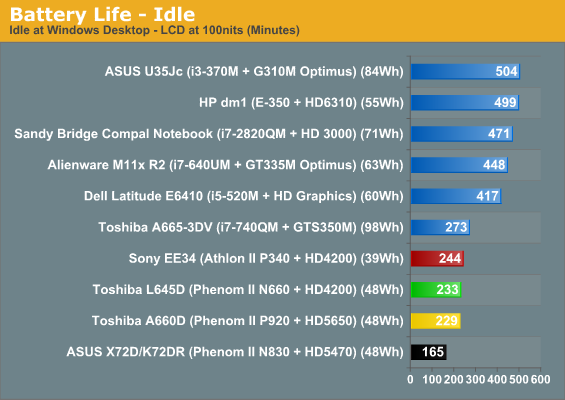
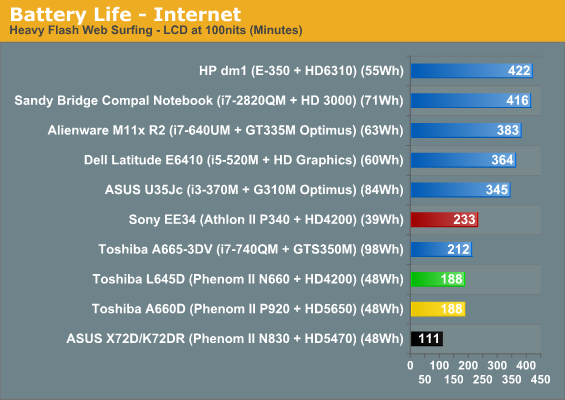
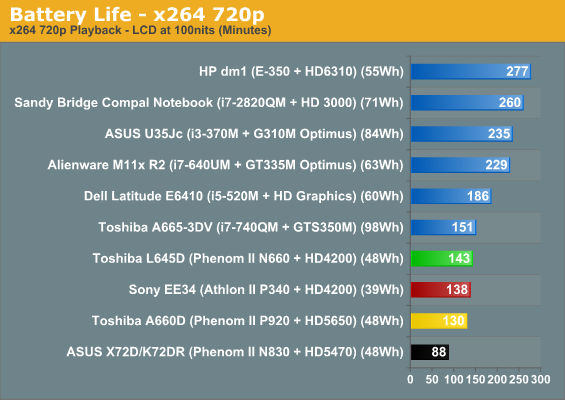
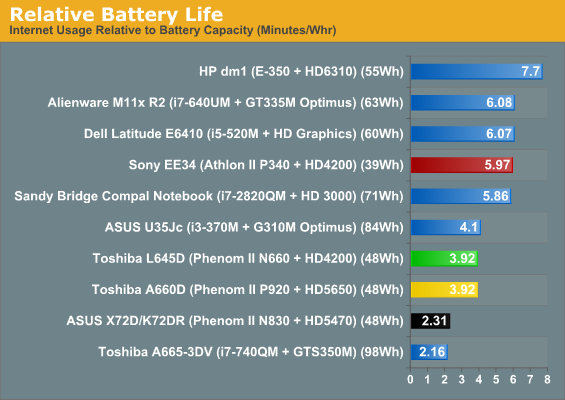
The relative battery life of the L645D isn't completely dire, but the Sony EE34's 25-watt processor runs roughshod over it. In practice, though, the L645D is still able to achieve three hours of useful running time surfing the internet. This is something Jarred's mentioned before and we've discussed at length: if you look at the running times of the Intel-based notebooks, you'll notice they're all equipped with much larger batteries. It seems like manufacturers almost deliberately cripple AMD-based notebooks.
We're not suggesting the L645D would offer battery life on par with an equivalent Intel machine, but it's still hamstrung by a middling battery. It's also clear there are power optimizations left on the table, as the Sony EE34 posts better battery life in two of the three tests despite having a smaller battery; the H.264 playback test is closer to what we'd expect, but the Internet test in particular has Sony leading by over 50% in relative battery life.
Heat and Noise
Given the smaller chassis of the L645D compared to some of the larger notebooks we've reviewed, it isn't unreasonable to expect it's going to have a tougher time dealing with the thermals of the Phenom II N660. We were pleasantly surprised.
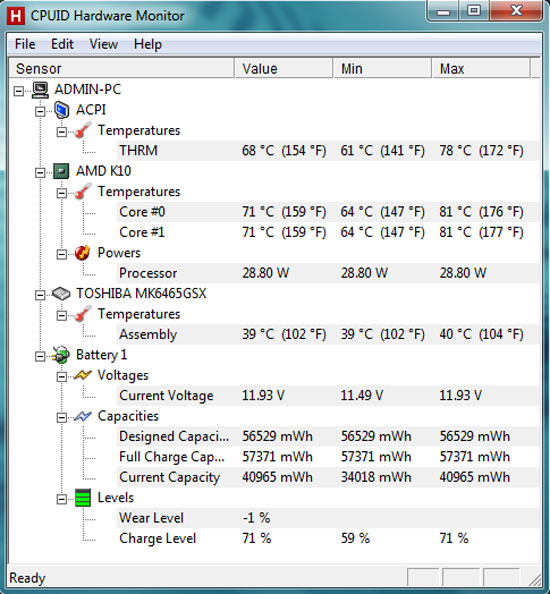
The processor temperatures are going to seem a little alarming, but they're not too far from where we've seen Arrandale-based notebooks hit. It may be better to look at the hard drive's temperature, which remains constant under both idle and load: 40C is perfectly reasonable. The L645D isn't in danger of overheating.
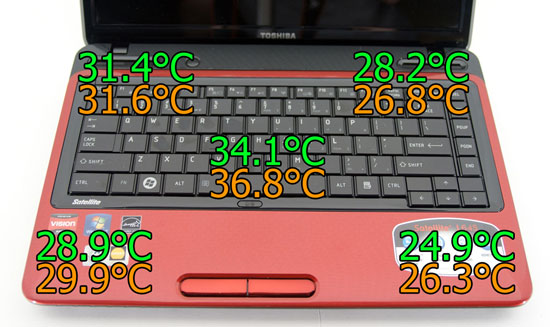
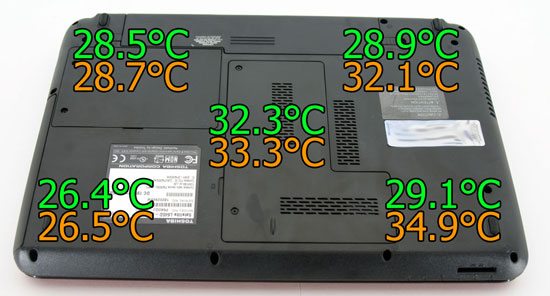
Idle and load surface temperatures are a little hotter than some of the other notebooks we've reviewed recently, but still nothing to complain about. Palmrests remain comfortably cool, as does the bottom of the notebook, with the center of the keyboard getting the hottest under sustained load. The central hot spot's 36.8C equates to roughly 100F, which is by no means cool but also not swelteringly hot either.
The L645D actually handles heat pretty well, and though the fan can definitely spin up noticeably under load, it's not aggravatingly loud and certainly not any louder than competing notebooks tend to be.










61 Comments
View All Comments
kmmatney - Wednesday, March 9, 2011 - link
Agreed. I have 4-year old 1930 x 1200 Dell, and had a look at a possible replacement. I couldn't find anything at Dell with more than 1080 pixels, and even that was hard to find and cost a lot. I have to give Apple credit for still using 1920 x 1200 resolution in their laptops. 1366 x 766 is total crap - especially with the extra vertical bloat in Windows 7.KiwiTT - Wednesday, March 9, 2011 - link
and on the 768 height, once you add the toolbars etc. You may only have half the screen left.Don't manufacturers do real user usability testing? If they did, they'd soon come to light that 768 is abysmally small.
bhima - Wednesday, March 9, 2011 - link
Your colorful language throughout the article made it a blast to read. Kudos Dustin!Dustin Sklavos - Thursday, March 10, 2011 - link
Thanks, much appreciated. :)helboy - Thursday, March 10, 2011 - link
"It seems like manufacturers almost deliberately cripple AMD-based notebooks."Had been my doubt also for the past one year or so!! Almost all the notebooks that carry the "not enough battery life" label after reviews,the battery provided will be of inferior capacity.AND the reviewers mostly ignore this fact when highlighting poor backup.I wonder whether winning the anti-trust case is helping AMD much in the marketing war.
cdeeter - Thursday, March 10, 2011 - link
+1 Yeah what's the deal with giving AMD systems smaller batteries? They are using the same chassis so use the same battery!silverblue - Thursday, March 10, 2011 - link
I can just imagine Intel realising they can't use one method to push AMD out of the market and then deciding to use another, albeit more subtle method. :P After all, battery life is king for a lot of people, so you need to prove those claims of long running times...And anyway, on an unrelated note, isn't it about time AMD got a stupid jingle for people to associate their products with? Everyone knows the Intel jingle.
jackylman - Thursday, March 10, 2011 - link
I picked up my new baby at a liquidation sale for the same price. It has the same CPU/GPU combo, but a 15.6" screen, webcam, gigabit LAN. On the downside, the hard disk is smaller (500GB) and no Blu-ray, but I'd rather have a bigger screen and a webcam.fumigator - Thursday, March 10, 2011 - link
Despite all the criticism, I like this laptop. Thanks for the great review.Only thing I would like to say is that I miss somehow the lack of nvidia chipsets on laptops.
I've owned an MSI VR630 that came with a geforce 9100 IGP and Turion X2 RM70 and I miss it all day. It was simply superb.
Later on the ATI 3200s and 4200s IGP started to pop up like maries and somewhat the 9100 started to look old. But even those MSI that came with Nforce 8200 and intel Core solutions were far better than any HD4500 based notebook. Lets say, MSI CR400, CR500, CR600 all came with Nforce 8200 and Intel something (Celeron dual core / Pentium dual core / Core 2 Duo etc, depending on submodel) Now they are all discontinued and nobody did serious reviews on them.
Moreover, i own an AM2+ motherboard with the Nforce chipset 8200 IGP as well, and I can't complain.
swaaye - Monday, March 14, 2011 - link
My mom wanted a notebook with a Bluray drive because she travels a lot for work and lives in a hotel for days at a time. So it's her mobile media center. I found a $600 Sony with a 2.0 GHz Core 2, 4GB and GMA 4500 something like 18 months ago.This Toshiba seems like the latest edition of that kind of thing. For what these are used for the performance might not even be tangibly different.